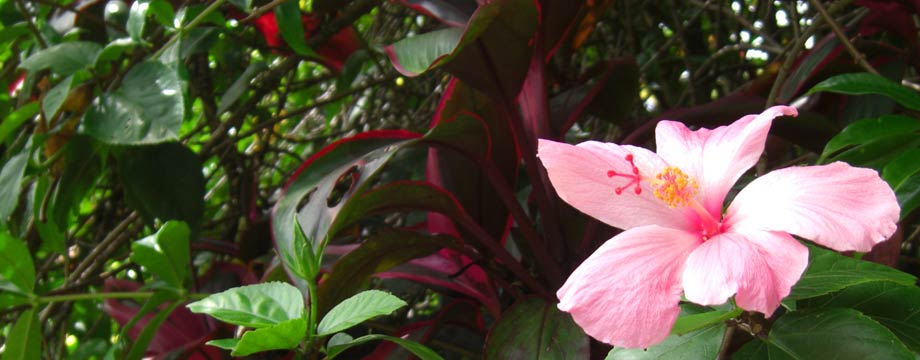I just got back from my SCUBA refresher course, and am pleased to say that the water was not as cold and murky as so many people made it out to be. Sure, fifty degree water is certainly not warm, but I felt much colder when I was on a surfboard a few weeks ago in Huntington Beach.
While on the bottom, at Breakwater, I went through all of the safety drills and then spent another twenty minutes trying to optimize my buoyancy over sand, rock, and kelp. While on the bottom, we encountered many perches, a baby flatfish, a greenling, senorita fish, kelp fish, a rock fish, tube anemonies, various sea stars, and countless other invertebrates.
It was nice not to have to buy any new gear, as I have all of the neoprene needed, and was able borrow the rest (thank you, you know who you are). So now it’s a little before ten and I’ve already been up for four hours. Perhaps it’s time for a hike…
Not as cold as I expected
Fish heads!
Some fish have the most expressive faces that seem to universally appeal to people. Others don’t convey much other than a sense of “duh”. What do you see when you look these fish in the eyes?
Black rockfish head!
Rainbow trout head!
Juvenile wolf eel head!
Morning Trout
Trout are, perhaps, the fish I first got hooked on, metaphorically speaking. Trout are almost certainly the first fish that I ever caught. I still remember going fishing with my family in a hatchery somewhere in the Sierras, and how effortless it was to catch a farmed fish in their rectangular ponds.
I remember Justin lowering a sphere of spit on a mucus strand from his mouth, until it reached the limits of tensile strength. The orb smacked the surface of the busy water below, and a trout almost instantly fell upon the loogie.
Perhaps it was a little less surprising that these trout, clearly not as wily as their wild kin, bit our chewed up gum that we had exhausted all of the flavor from. The farmed trout bit upon unbaited hooks, and really cemented the idea that farmed fish are much less fit, both genetically and mentally, than wild fish.
Nonetheless, it is this memory, and other memories of looking for fish and fishing in lakes, rivers, streams, and ponds that secure the rainbow trout a special place in my heart.
One thing that still surprises me is how weak trout are when they come into contact with human activity. They are easily killed by messing with their water quality, by hooking them in the gills or if they swallow a hook, or even by touching them. But they are able to live in both salt and fresh water, to jump waterfalls to reach their spawning grounds, and some of them, the legendary uncatchable monsters, seem to be able to out fox any lure, bait, or fly that passes their way. Trout, like people, capture the concenpt of the tension of opposites.
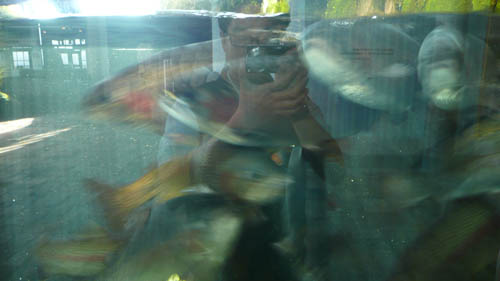
I no longer like to fish for trout the way I used to when I was a kid. Part of the reason I don’t like trout fishing is that I don’t want to hurt or kill them because if I did I would feel obligated to eat them. I have had rainbow trout that taste pretty good, but I have had this fish prepared the wrong way or trout that was simply disgusting enough times to make me want to avoid it all together.
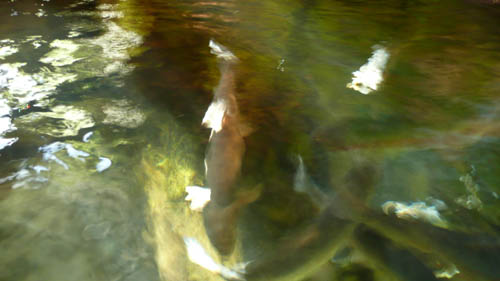
If you look at hatchery rainbow trout versus wild stocks, they look like different species of fish, though they are almost genetically identical. The wild strains tend to be darker colored, exhibit sexual dimorphism, and just look healthier. They also tend to be a little more wary than their inbred brethren, and I imagine they would taste better.
It would be interesting to see how long it would take hatchery fish to go back to looking and acting like native trout. How many generations would it take for these less-fit fish to optimize their behavior and characteristics to fit an environment that they are only generally suited to live in? Would interbreeding with the native stock be a good thing or a bad thing to replenish the local populations?
I think the answers are out there, but I know not what they are. But then again, I haven’t dedicated much time to finding them yet.
Woodblockesque
The landscape and seascape changes from hour to hour, day to day, season to season, all the way up the progression of increments of time. It is during my time spent in the outdoors that I feel like I am living in an old Hiroshige woodblock print. In a sense, I am probably capturing the same stuff he would be interested in, albeit in a much newer and less time-consuming medium and as an amateur:
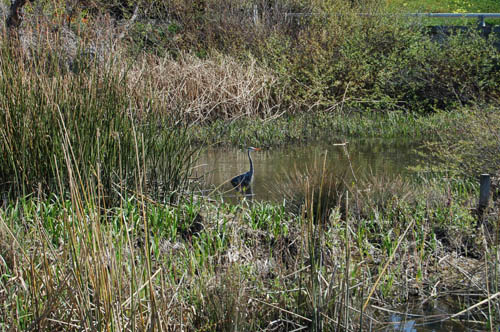
A heron takes cover among the reeds that grow near the end of the Carmel River. On a sandbar I find some rocks that might turn out to be jade, or maybe they’re some other kind of greenish rock. I walk along the top of a sand bar, heading up the coast. This is the start of what will become a two hour long hike.
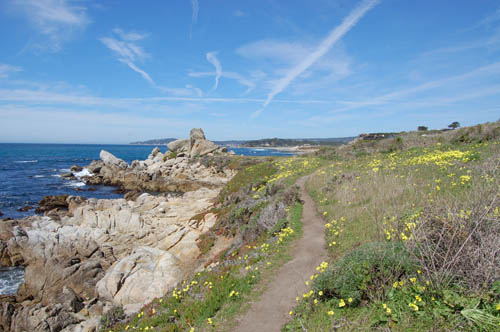
The proper trail is not easily found from the beach, and it appears that most of the hikers are retired folks who own the houses that you can see peeking out over the hills. The flowers are in bloom, and the weather is perfect on this afternoon. As the only young person on the trail, and the only minority, I feel more out of place than if I was in a foreign country. I opt to explore the uneven grounds of the beach, away from the houses and their owners.

My plan works flawlessly. It seems that no one is interested in walking along the beach, and I have it all to myself. The colors I encounter on this section of my walk do not seem as if they should all occur together at the same place in nature. My gait slows from Osaka speed down to a nice Kyushu pace.
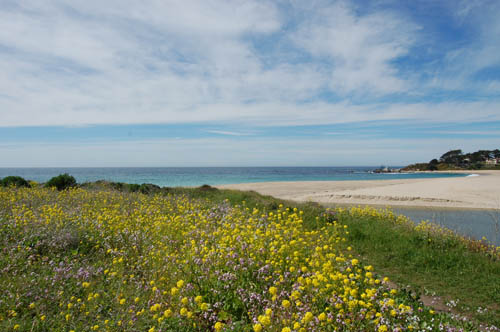
I jump back on the trail after reaching the junction of an unscalable sandstone cliff (no iceplant here!) and delta. No fish are visible from the edge, only a huge flock of sea gulls who are busy bathing in the fresh water.
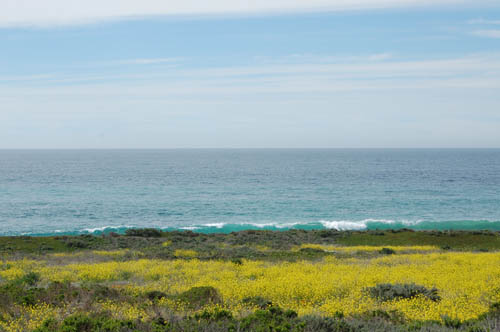
I continue along the trail, and gaze down on the fields of sourgrass sitting next to the crashing waves. For the explorers who had to tramp through thick forests, plague-ridden swamps, bone-bleaching deserts, and all of the other obstacles and challenges, views like this must have helped to balance out some of their hardship and suffering. It pains me to think that some of those explorers probably enjoyed a view similar to this as they unwittingly rubbed up against a huge patch of poison oak (which also looks beautiful this time of year).

The trail, once again, veered toward the sprawling houses along the beach, and so I once again took a small, neglected trail. It appeared to be used mainly by maintenance crews working on the water lines that fed the neighborhood, and the furry woodland creatures, judging by the various turds (thankfully none human) and tracks that they left.
This part of the hike could have come straight out of the back roads of rural Southern Japan. Like many of my hikes along the many neglected roads, I encountered not one person, but many strange and beautiful plants and animals.
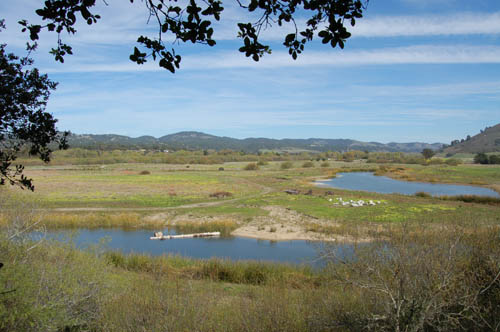
Why is the Pacific Grove Natural History Museum filled with such a variety of stuffed birds? Back in the old days, I have no doubt that the men who collected and prepared many an unfortunate avian bagged not a few of them somewhere within the view afforded from this hill side.
I find it highly amusing that hunting groups, like Ducks Unlimited, are the main evangelists of conservation of natural areas like these. Groups who kill the animals who live here have shifted to become their stewards. This is how most resources will have to be managed in the future, by those who traditionally exploit them. But I digress…
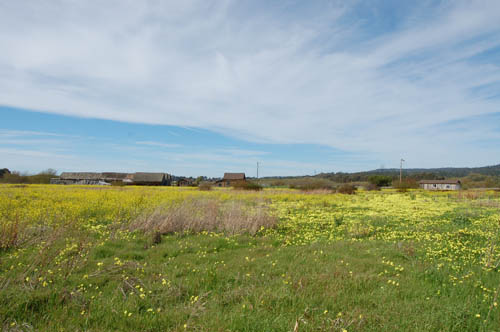
My hike ends in a fallow field, with a collapsed barn in the distance. In the space of two hours, it seems like I have experienced much more than I should have been able to, even if I was given a whole day. This, I reflect, is why some people have the exploration bug. Even if you get lost, hungry, scared, angry, or hurt, you know that you may come away richer for the experience. And maybe, if you are really lucky, you can have it all, if just for a moment.
The Happy/Sad Floating World
A few days ago I took a long walk that started at the beach. After a few hours of following no particular path, I ended up in a large meadow next to the highway. If I had not strayed from the path and scrambled along the edge of the emergency lane into what was almost certainly private property (though there were no “no trespassing” signs posted), I would have never hopped down the steep bank where I found this:
I had chanced upon a cherry tree in the middle of nowhere, and it was in full bloom despite its dire situation.
Cherry blossoms are not long-lived, and it’s partially because of their fleeting beauty that many people look forward to the season when they start to open. On the slope, surrounded by eucalyptus trees, poison oak, and dull colored scrub, it would have been impossible to miss.
The trunk was snapped, like a matchstick, at a 90 degree angle. It was impossible to see from the road, and since there was no footpath, its flowers were not likely to be seen by anyone who passed it by. I found it amazing that this tree, which appeared to have been broken a while ago (the splintered trunk was brown and dried out, with only a tenuous patch of fiber connecting the fallen portion of tree to the trunk), was able to flower despite being fatally injured.
It made me sad that no one would probably ever see this tree, or witness its last death-defying act of beauty. I regretted not having packed any food or drink to enjoy in its company, as I so often had under so many different cherry trees with so many different people when I was living in Japan.

The hike back to my car was long and the wind conspired to pull away all of the petals from the branch that I took. The branch, it turned out, was stronger than I thought and made it home safely.
And so, with this branch, I was able to enjoy hanami in my apartment this year. We dined on tuna melts (with croissants) and sparkling fruit juice. To someone who doesn’t count any specific residence as their home it made the apartment feel familiar in a way not too different from nostalgia (How the hell do you translate natsukashii in this context?).
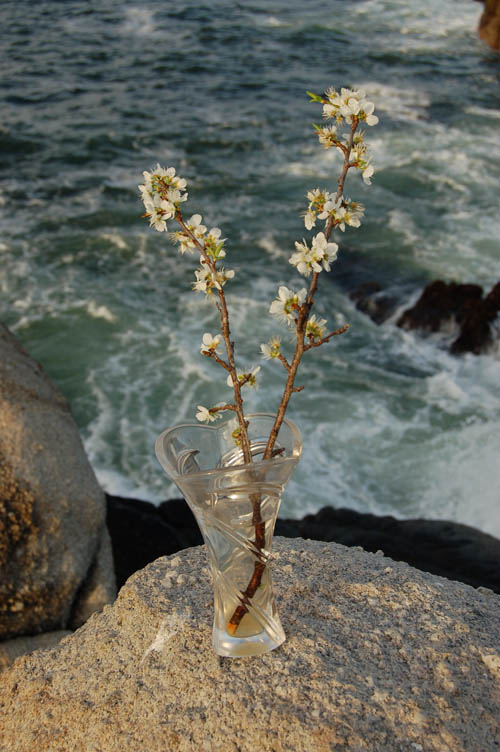
I was amazed, but the branch was still obstinately clinging on to its blossoms the next day at dawn. I had wanted to take pictures of the branch the day before, but had run out of daylight. These are the shots that I came away with at Lover’s Point.
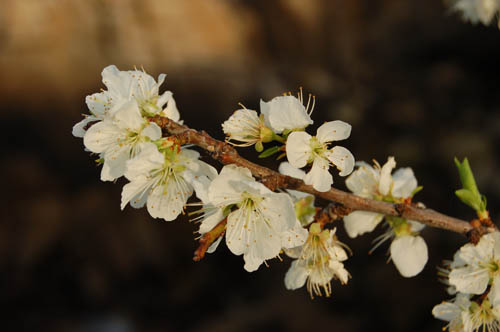
The twig was with me for only a couple of days, but during those days I had some good times enjoying the cherry blossoms.
A fallen, dying tree puts all of its remaining energy into blooming one last time, though no one will see it. Against all odds, the right person finds it and enjoys this last beautiful act. Though the tree dies, it is fondly remembered, tied into happy memories of the past.
Sound familiar?
Raw Material
Perhaps it’s because I have my Nikon back in working order. Or maybe it’s because I have an extra free day each weekend. It could be that winter is finally fading away.
What ever it is, I was able to find interesting things this weekend, which I hope to post soon.
Here’s a shot that captures so many textures and colors, it was hard to believe. Why is the sand that purple and why does the water look so deceptively inviting? I don’t know, but I do know that I found a new favorite beach hike…
Among the Wildflowers
It’s been a while since I’ve felt like taking pictures of, writing about, or even just thinking about flowers. For a stretch, I wasn’t motivated to go out and find them, or for one reason or another, I didn’t take the time to just go outside and look at them. Now, I feel like I’m ready to go forth and to dedicate some time to them like I did during the past few days off.
These blue flowers were thriving among the border of a road along the backwoods of Fort Ord, perhaps sitting atop some yet undiscovered ordinance. There are signs at the trailhead, warning hikers to avoid the various unexploded shells and explosives that are occasionally found in these parts.
This white flower was only growing in one small patch, next to some really small yellow flowers. I really love the tiny wildflowers that thrive during the spring. Perhaps I can use them as an excuse to get a better lens!
By the way, if you were wondering why I haven’t been posting pictures, it’s because my old lens died, and I had to search for a replacement. I found the same lens for cheap (refurbished!), but I don’t think I’ll be spending any more real money on this camera.
What I have learned is that, although the stock Nikon lenses work well, they are not very solidly constructed (a cool repair guy told me that they have tape holding them together inside!) and are not made for rugged conditions or heavy use. The general consensus, from the camera guys I talked to, was to go for the high-end lenses, starting from $500 to $600 bucks. I’m not sure if I would be comfortable pouring that much into my camera, as you can almost buy one new with two lenses, albeit cheaper lenses, for only a little bit more.
The bottom line is that I’m happy to have my camera working again. I intend to get into the field in the near future…
Benny Lava!
This is like the Bollywood version of Yellow Ledbetter:
Why big dogs are better
Though I am fond of my family’s lap dogs, I don’t understand the popularity of small dogs. Big dogs are much better.
Dogs are supposed to be Man’s best friend, and long-dead dogs that we still fondly remember are the ones that fearlessly protected or faithfully served their masters.
Old Yeller, Rin Tin Tin, Lassie, Hachiko, Balto: these are the names of dogs we remember for doing something other than promoting cheap tacos. Benji is the only small dog that was relatively worth a damn despite his small size.
Little dogs taken into public, especially if they are wearing clothing or carried in a bag are a red flag. Sometimes the owners are regular people who like small dogs. More often than not, they indicate that their owner has a better than average chance of being selfish, annoying, and just generally someone you wouldn’t want to waste your time on. In my experiences, it is best to avoid such parties, if possible. This isn’t to say that people who own big dogs aren’t the same way, but unpleasant owners of big dogs tend to be unpleasant in different ways than unpleasant owners of small dogs.
Small dogs can be formidable ankle biters, but they are nothing that a decent punt can’t handle. Big dogs, like this one, can literally kick your ass. And if that fails, they can bite it…

